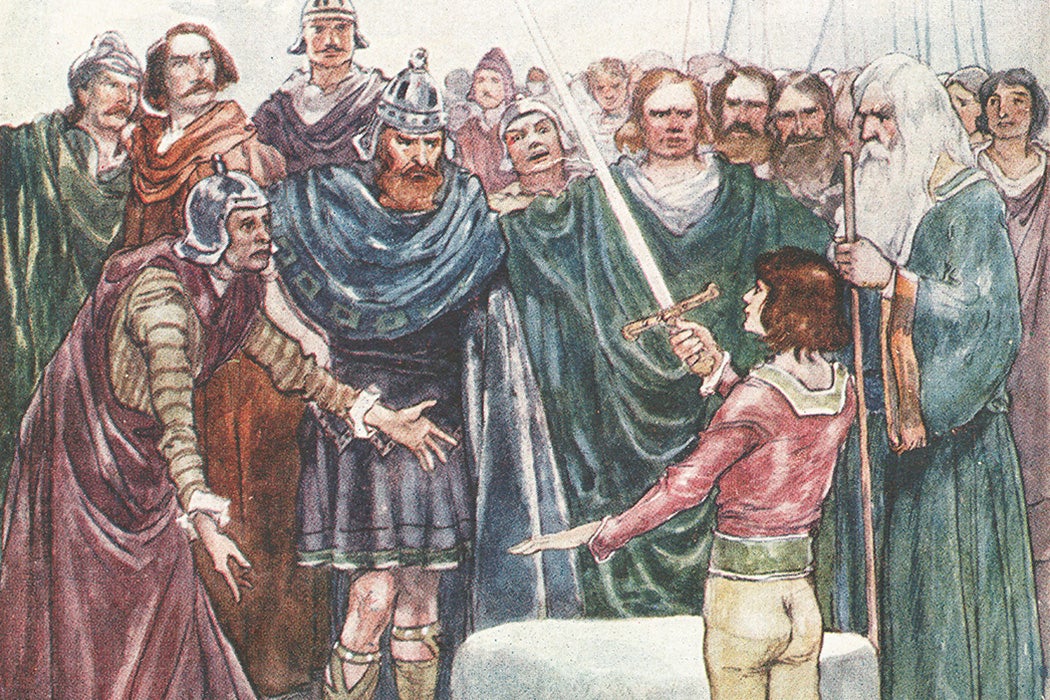Followers of QAnon recently gathered in Dallas’s Dealey Plaza for what was billed as an appearance by John F. Kennedy, Jr., who, after returning from the dead, would somehow restore the previous President to power. He never showed. Followers evidently believe that JFK, Jr. did not die in 1999 and has been in hiding since. A similar gathering on July 4, 2019, proved equally fruitless.
However bizarre it seems, this cultic conspiracy theory has parallels in folklore. Resurrected gods and hidden or sleeping heroes have a long tradition; in fact, those who catalogue folkloric motifs even have designations for these cultural manifestations. In Stith Thompson’s motif index system, for instance, A580 is the “Cultural hero’s (divinity’s) expected return,” and D1960.2 is “Kyffhäuser” (see below.)
The hero/king/god isn’t dead, he’s just sleeping, often under a mountain, waiting for the day his people really need him.
Such was said of the legendary Irish hero Fionn mac Cumhaill (Finn MacCool), as well as actual historical figures like Charlemagne (748-814) and Frederick Barbarossa (1122-1190). The posthumous legend of Barbarossa gave this archetype one of its names: Kyffhäuser was the mountain in Germany where Frederick was supposed to sleep. The Barbarossa myth was enlisted by German nationalists during unification in the late nineteenth century and then symbolically resurrected by the Nazis as an inspiration for their “thousand year reich.”
The most famous of these sleeping heroes in the English-speaking tradition is undoubtedly Arthur, mythic king of the Britons. Medieval Arthurian romances sang that Arthur never died. He slept on Avalon, the isle of fruit trees, awaiting the day his people would call him forth again. In some versions, all the king’s men and all the king’s horses are also slumbering with him.
Scholar Megan L. Morris explores how Arthur was “recalled to life” in nineteenth-century England to serve historiographical and political ends.
“Nineteenth-century historians, authors, and artists were fascinated by the revival and reinvention of the heroic male body as a vehicle for historical consciousness. This fascination frequently drew upon legends of Arthur’s survival and eventual return to save England.”
Arthur’s nineteenth-century resurrection/manifestation was cultural, literary, and historical, especially in popular history. Morris calls it a kind of “necromancy,” a magical revival of the dead, a metaphor made… almost-flesh. “Imagination appears as a key element of historical discourse; it materializes the past and transfers the nobility of past heroes onto modern bodies,” she writes. Such fictions were considered necessary to “excite the sympathy and moral sentiments” of history’s audience (middle-class Victorians). The myth needed to be embodied.
Weekly Newsletter
The fascination with materiality, so “characteristic of the Victorian drive to possess its past” included a “growing drive to pinpoint the location of Arthur’s body.” People searched for Avalon in Glastonbury, England, and off the coast of Brittany. Though the actual “physical inaccessibility” of Arthur bedeviled Victorians, Alfred Tennyson’s Idylls of the King, one of the most important parts of this Arthurian revival, was frequently applauded for the way it made Arthur seemingly live again.
Morris writes that after World War I, “the incarnation of Arthur’s historical body weakened; it was no longer strong enough to stand up to the machinery of war.” Instead, the myth of the sleeping hero was transferred to memorialization of the war dead in Britain, and to an even greater extent in Germany. The many killed were said to have “moved beyond the plane of this world, but ready to aid the living in another time.” Yet not even their example could do anything to prevent the next great war.







